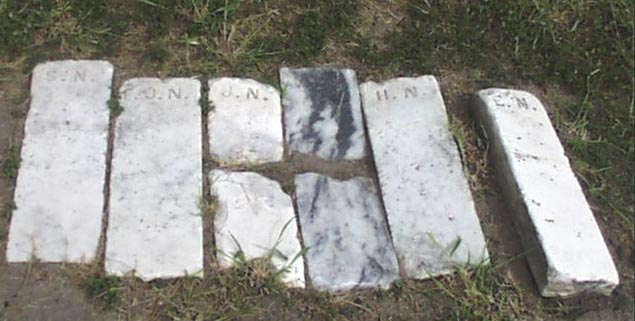Newmans

Photo Credit: Rosa G. Gonzales
These footstones are associated with the area in which the Newman family members are buried and those names are identifiable with most of the footstones. The Newman family was an African-American family that was present in Corpus Christi, and a record of the family is found as early as the 1870 census. Further information on the individuals can be found under their particular names. The footstones include the following initials and likely identification:
- S. N.—These initials refer to Sam Newman, son of Henry and Fannie J. Newman. He is listed along with his sisters on one side of the pillar stone that marks the graves.
- F. J. N.—Fannie J. Newman, wife of Henry Newman and mother of Ellen, Samuel, and Julia Newman. Only Fannie has her date of death and age listed on the stone. The name “H. Newman� appears below her information and probably refers to her husband Henry Newman. This would mean the parents’ names are on one side of the stone, and the names of three siblings are on another side of the marker.
- J.N.—Julia Newman is the daughter of Henry and Fannie and youngest sister of Samuel Newman.
- H. N.—These initials would presumably be intended to indicate that Henry Newman is also buried in this group plot although his name is not usually listed among those buried in Old Bayview Cemetery. His name, however, does seem intended for remembrance by the way it is carried also on the side of the main stone under the information on his wife Fannie.
- E. N.—These initials presumably refer to Ellen Newman whose name is on one side of the main marker. She is an older sister to Julia, but about a year younger than Samuel.
One stone in the photo given seems out of place and that is the one with initials “V. F. R.�. This particular footstone is near the Newman family area but appears to be a footstone for “V. F. Richeson� who is buried in that same area of the cemetery. This person is listed as born in Taylor County, Kentucky on 12 February 1867 and died in Corpus Christi on 18 October 1896. This individual is “Virgil F. Richeson� who is a son of George and Nancy Richeson. He is found in family genealogical listings and in the 1880 census records of Taylor County, Kentucky. However, there is no indication he is in any way related to the Newman family.
Footstones
Originally a tombstone was the stone lid of a stone coffin, or the coffin itself, and a gravestone was the stone slab that was laid over a grave. A headstone was a marker placed upright near the head of the coffin. Now usually all three terms are used for markers placed at the head of a grave. Beginning in the 1700s graves also might contain footstones to demarcate the foot end of the grave. Footstones were rarely carved, and they were small enough that most cemeteries removed them to make cutting the grass easier (see article from Wikipedia on gravestones). Footstones consequently are traditionally used only in conjunction with headstones and often (as in the case of Old Bayview Cemetery) bear only initials as inscriptions. The footstones in Old Bayview Cemetery are small flat cubes of this variety (bearing only initials). The identity of the person referred to in the footstone can only be deduced based on the initials given, the existence of the original headstone, and the presumption that the footstone is still in or close to its original site. Unfortunately there is no assurance that footstones have not been misplaced over the years. Consequently any identifying of the footstone’s owner can only be a logical guess.
Research and transcription: Michael A. Howell